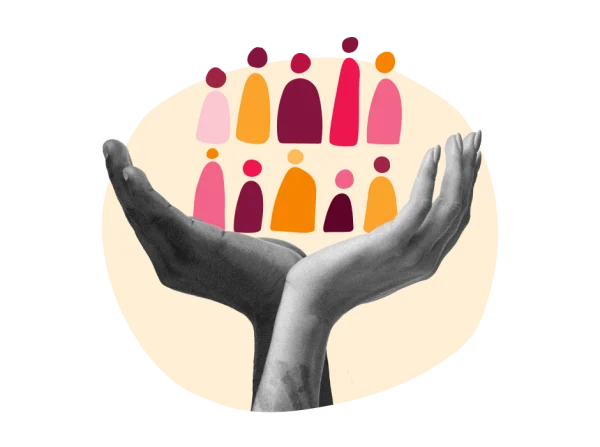Truly modern and inclusive workplaces create environments where people feel safe and encouraged to actively and equally participate in company culture no matter who they are and how they identify. Getting this right can be challenging, especially for team members who identify as non-binary and/or trans.
According to a Pew Research Institute study from 2022, one percent of US adults identify as non-binary. Among adults under 30 at the time of the study, that number rose to 3 percent. When you add the transgender community into the mix, those numbers rose even further to 1.6 percent for all adults and 5.1 percent for 18-29-year-olds.
Additionally, in a 2023 global survey, 3 percent of respondents from 30 countries identified themselves as transgender, non-binary, nonconforming, or gender-fluid. This means that a significant proportion of the talent out there identifies as non-binary and/or trans, and it’s likely that their representation in the workforce will continue to grow.
Visibility is on the rise, but while the acceptance of trans and/or non-binary individuals is improving in some cultural spheres, trans and/or non-binary individuals face particular challenges in the workplace that are distinct from other LGBTQIA+ professionals.
It’s down to HR leaders to build a framework that creates a culture of inclusion, understanding, and sensitivity. By establishing good policies and practices, managers and senior leaders can educate the organization, cultivate an inclusive environment, and empower everyone to eradicate discrimination from the workplace.
Plus, establishing a company culture based on these practices will help you stay competitive when searching for the brightest talent out there and help move society toward a future of broader acceptance of non-binary and gender-nonconforming individuals.
This guide will explore why it’s important to support transgender and non-binary employees, what policies you can implement to champion an inclusive culture, and, specifically, how to refine your company policy regarding the use of pronouns.
Let’s start with the basics.

Key insights
- Non-binary gender inclusion is essential for creating a supportive and equitable workplace environment
- HR leaders play a crucial role in implementing inclusivity, like providing gender-neutral restrooms, pronoun recognition and implementing comprehensive sensitivity training to build understanding and reduce workplace discrimination
- Legal protections for non-binary individuals vary globally, highlighting the importance of proactive employer policies
What is non-binary? Definitions and context.
First, it is necessary to clarify the distinction between biological sex and gender.
Sex is generally assigned at birth according to physical and physiological attributes—namely, chromosomes and reproductive anatomy.
Gender, on the other hand, denotes socially and culturally constructed expressions and identities. In modern Western societies, gender has been conceived of in binary terms, e.g., “Ladies and gentlemen, boys and girls.” This binary, however, is increasingly being challenged by individuals who do not identify with the gender that corresponds to their assigned sex at birth or with one of the binary genders.
A person who defines themselves as non-binary doesn’t identify within the traditional gender binary of man vs. woman. That might mean that they identify as both, neither, somewhere in between those two genders, or as another identity on the non-binary gender spectrum (more on that below!). While non-binary people may also identify as transgender, that is not a given.
Non-binary laws, workplace rights, and compliance
Today, advocating for diversity and inclusion in the workplace is a benchmark of a healthy company culture, but this was not always the case.
In the United States, the EEOC (Equal Employment Opportunity Commission) was created as part of the pivotal Civil Rights Act of 1964. This act was an effort to redress pervasive racial discrimination in voting, education, and other aspects of daily life, including discriminatory hiring and workplace practices. The EEOC was founded to promote equality, inclusion, and desegregation—but it took some time for these to be extended to sexual orientation and gender identity.
Throughout the 1970s and 1980s, activists pressed the EEOC for change. But, it wasn’t until 1989’s Price Waterhouse v. Hopkins verdict that the Supreme Court finally ruled against workplace discrimination based on sex stereotypes.
Furthermore, the extension of these protections to trans and non-binary people is still not complete. Although the act’s Title VII includes “sex” and “gender” in the list of protected categories, legal debates continue about its applicability to the LGBTQIA+ community and especially to the trans- and non-binary communities.
In light of more recent events concerning the executive order, Ending Radical and Wasteful Government DEI Programs and Preferencing, issued by Donald Trump on January 20, 2025 that seeks to put an end to all DE&I “mandates, policies, programs, preferences, and activities in the Federal Government, under whatever name they appear” and branding diversity efforts “illegal,” it is critical to note that the executive order does not replace statutory laws like Title VII.
It is also critical to note that EEO reporting has historically only recognized “male” and “female” binary gender classifications, leaving no option for employees to legally identify as non-binary. To account for those who choose not to self-identify, employers may use legal documents provided by the employee, such as ones used for I-9 forms.
Employers may also use visual identification to designate these employees as either male or female for purposes of completing EEO-1 reporting requirements. Private-sector organizations can support non-binary team members by enabling self-identification in their HCM system and promoting a compliant and inclusive culture where everyone feels safe and valued, regardless of shifting sociopolitical landscapes.

The need for employers to take initiative
Globally, non-binary and/or transgender people continue to face disproportionate levels of aggression and exclusion in the workplace.
McKinsey found that cisgender employees make 32 percent more money a year than transgender employees, and research by myGwork found that gender-nonconforming and queer people experience the highest rate of discrimination at work (81 percent), followed by cisgender women (76 percent), gender-fluid people (75 percent), intersex people (68 percent), trans women (66 percent), and non-binary people (65 percent).
This appalling state of affairs needs to change, and the surest way for this to happen is for employers to take initiative.
Serious lags in the application of anti-discrimination legislation and the inadequacy of its scope do not stand in the way of building a better workplace: It is up to employers to implement policies and processes to promote inclusion and protect transgender and non-binary team members from discrimination and harassment.
Building these policies begins with understanding the many ways people may self-identify. Take a look at the glossary of terms below to get more acquainted with any terms and identities you may not be familiar with.
A glossary of terms: Different types of non-binary identities
People with a gender identity outside of the binary may self-identify in several ways, including gender-nonconforming, gender-fluid, gender-expansive, genderqueer, or two-spirit. In addition, they may also identify as transgender, though not all do. The range of terms can be confusing, and this confusion can lead to unintentional insensitivity toward non-binary and trans individuals in the workplace.
Therefore, understanding this vocabulary and promoting understanding across your organization is the first step toward positive change.
| Term | Definition |
| Gender identity | The personal experience and deeply felt self-understanding of one’s gender—this is distinct from biological sex |
| Gender expression | How an individual expresses their gender identity |
| Sexual orientation | How a person defines the genders to which they are sexually attracted—this is often intertwined in conversations about gender identity but it is a fundamentally different concept |
| Non-binary | An umbrella term for a person who identifies as neither male nor female, instead identifying as: -Both of the binary genders -Neither of the binary genders -Between the binary genders -Moving between the binary genders -Having multiple genders -Another recognized gender -Another undefined, unnamed, or blurred gender -Neutrally gendered -Ungendered |
| Cisgender (or “cis”) | A person who identifies with the gender that was assigned to them at birth, although they may still express their gender in non-conforming ways |
| Pronouns | Third-person gender identifiers, such as he/him/his, she/her/hers, and they/them/theirs, etc. |
| Gender transition | A personal process that may involve gender confirmation surgery, hormone therapy, name changes, attire, and/or pronoun shifts—or none of these things |
| Gender-nonconforming | An expression of gender outside of traditional binary expectations, such as in clothing, makeup, or hairstyle choices |
| Transgender | Individuals who identify with a gender that is not the same as the one they were assigned at birth |
| Gender-fluid | A gender identity that changes over time |
| Agender or gender-neutral | Also known as neutrois or xenogender, these individuals do not identify with any gender, may present in different ways, and may have a range of pronoun preferences |
| Intergender | Someone on the spectrum between male and female—they may also use the term “demigender” |
| Pangender | Someone with multiple gender identities |
| Third-gender or other-gender | Someone identifying as another gender, such as those recognized by Samoan fa’afafine or Indian hijra cultures |
| Androgynous or androgyne | Someone with a combination of male and female gender identities |
| Two-spirit | A term used by some Indigenous peoples to identify as having both a masculine and feminine gender, sex, or spiritual identity |
Understanding why supporting trans and non-binary communities is important
The modern workplace is more inclusive than ever before—accommodating people of different ethnicities, cultures, gender identities, religions, sexual orientations, and abilities. By implementing systems and processes that promote sensitivity and acceptance, all types of individuals can find themselves a home at work.
Considering that diversity and inclusion were foreign concepts until the middle of the last century and discrimination in the workplace was common practice, this is a welcome evolution. However, despite significant strides toward diversity and acceptance in the modern workplace, there is still more work to do.
Non-binary and/or transgender individuals suffer disproportionate levels of unemployment, poverty, and homelessness compared to their cisgender counterparts. Disqualifying skilled professionals from work based on their gender harms society at large because when we exclude these talented individuals, we deprive ourselves of the invaluable contributions they have to offer us all.
In fact, McKinsey estimates that a focused effort to increase employment and wage equity for transgender people could boost annual consumer spending by $12 billion a year. In this sense, it is in the best interest of employers to combat stigma and create opportunities for non-binary and trans candidates.
It is also important to note that the complex challenges facing non-binary individuals are even more pronounced for non-binary people of color, people living with disabilities, and undocumented people. This economic instability and workplace mistreatment faced by individuals with intersectional identities necessitates special consideration: Employers and recruiters are responsible for making a positive impact by implementing inclusive hiring and management policies and practices.
Despite workplace discrimination being illegal in some countries and US states, it remains a serious obstacle for trans and non-binary people, and legal protection varies dramatically. Discrimination and unequal treatment may not be overt, for example, in the form of blatantly discriminatory hiring practices, but stigma continues to pervade office culture.
Slurs and inappropriate jokes by co-workers, pay inequities, discrepancies in how managers evaluate a team member’s performance or allocate assignments, disparities in promotional practices, and other insidious forms of discrimination are not uncommon and are particularly glaring for non-binary, trans, intersex, or other gender-nonconforming professionals.

Recommended For Further Reading
Creating policies that support transgender and non-binary inclusion: Best practices
The trans and non-binary communities face two major challenges in the employment world: acquiring and maintaining employment and being secure in the workplace.
There are concrete steps that HR leaders can take to combat stigma and foster a safe, supportive environment for trans and non-binary people—in turn, helping you attract and retain more skilled professionals.
Here are nine best practices for removing barriers and enhancing workplace inclusion:

1. Protect gender identity and gender expression
A healthy workplace provides everyone with a safe environment where they can feel confident in bringing their whole selves to work. An anti-harassment and zero-tolerance discrimination policy is critical to ensuring the safety of all your employees, customers, and guests.
It’s also vital to make it crystal clear to candidates and new recruits during the hiring and onboarding processes that you protect gender expression (e.g., attire or hairstyle) and gender identity—without exception. Include the fact that you’ll respond to any infringements and provide close support to anyone who transitions or comes out as non-binary and/or trans at work in your policy.
2. Encourage gender expression
While many offices have dress codes, these should not exclude team members who express their gender. Modify uniform clauses in your dress code policy to be gender-inclusive and apply them consistently to avoid perpetuating gender stereotypes and alienating non-binary team members.
Another important way to protect gender expression is to give everyone the ability to self-identify on HR platforms and systems. To support this, the HR team can include an inclusive list of pronouns and genders for administrative systems and forms.
3. Protect people’s privacy
Protecting people’s privacy is paramount, and outing candidates or team members against their wishes is not only hurtful, insensitive, and inappropriate, it can create serious physical and emotional safety concerns.
At work, supporting trans and non-binary professionals starts at the hiring stage. For example, recruiters and hiring managers may only become aware that a candidate is transitioning after the hiring process is well on its way.
Background checks, references, social security, and other documents may contain pre-transition information, including a person’s birth name (often known as their “dead name”) and the gender assigned to them at birth—and out them during the recruitment process before they’re ready.
This means that in addition to avoiding bias in hiring and throughout a person’s employee lifecycle, it’s just as important to be discreet and mindful that you may be receiving sensitive information not because someone wants to be out at work but because the conditions of their employment or legal work requirements mandate them sharing this information.

4. Support transitioning employees
It is crucial to delineate clear guidelines for people transitioning and their supervisors and colleagues. These protocols may range from something as simple as how you’ll handle announcements about name and pronoun changes and promote correct pronoun usage across the company going forward to allowances for working remotely, paid leave, a hygienic and private room for administering hormone injections, a process through which employees can raise concerns about misgendering and mistreatment during and after their transition, and other accommodations.
Developing a supportive environment in the workplace during and after transition—including health benefits—is vital.
5. Implement comprehensive sensitivity training
Ignorance is a major contributing factor to the exclusion and mistreatment of non-binary and/or trans individuals in the workplace. It is vital to engage staff and implement comprehensive sensitivity and anti-harassment training. This will empower everyone to advocate for and practice non-binary and trans inclusion, both within the office setting and without.
6. Facilitate documentation changes and options
Transitioning is hard enough as it is, but bureaucratic foot-dragging can make the journey even harder. It may take months or years for authorities to confirm a legal name change or gender change. Additionally, many government forms and documents only allow for the selection of one of two genders. Even the EEOC didn’t provide an option for a third or other categories for gender until 2022—and that’s only in the form of filling in a free field as opposed to an official option on the form.
For non-binary individuals, this can mean being forced into checking a box that doesn’t actually correspond to their gender. Or having multiple forms of ID, some with the gender they identify with and some that list their gender assigned at birth.
To support all your team members and foster an inclusive work environment, it’s equally important to use people’s pronouns and chosen names when you address them and in any documentation that doesn’t need to match their legal name and sex (for example, insurance documents or official payroll). This includes all written and verbal communication, such as email, business cards, nameplates, phone directories, identification cards, websites, etc.
Once a legal name or gender change is official, swiftly update any legal documents to match. Consider also including additional gender categories across workplace documentation. By offering everyone the opportunity to designate their gender beyond the binary, your company is signaling a culture of acceptance and support.

7. Establish bathroom and locker room access
One of the most prominent topics in the conversation around non-binary inclusion in the workplace centers on gendered bathrooms. Forcing people to use facilities that do not correspond with their gender is harmful and discriminatory.
Some options for overcoming bathroom discrimination are:
- Single-occupant, gender-neutral bathrooms
- Multiple-occupant, gender-neutral bathrooms with private, single-occupant stalls
- Avoiding gendered signage on any stall or facility doors to prevent unnecessary discomfort
8. Adopt inclusive health insurance policies
Most employer-sponsored benefit plans in the US do not provide for gender-affirming and transition-related care unless employers specifically request and fund it. This means companies that want to truly support their non-binary and/or trans team members must go above and beyond.
The most inclusive employers offer whatever transition-related health care they are legally allowed to in their state or region—fully covering gender confirmation surgery, mental health counseling, prescription drug or hormone therapy, and other treatments commonly utilized by trans and/or non-binary individuals. The most inclusive plans also include short-term disability coverage following gender confirmation surgery.
9. Actively recruit individuals from marginalized communities
The discrimination and exclusion faced by trans and non-binary individuals mean that it is necessary to take proactive measures to engage with potential recruits who identify as members of these communities.Evaluate your talent sourcing process to ensure inclusion and publicize your socially responsible policies to attract highly qualified candidates who are either trans and/or non-binary or are seeking a more inclusive workplace. Consider engaging with targeted professional organizations such as Trans Rally and Out in Tech for advice and guidance.
Building a company-wide pronoun-specific policy
One of the most important ways to include trans and/or non-binary employees is to use their pronouns correctly. By and large, using binary pronouns like he/him or she/her is just how most people speak, without being consciously aware of their usage. However, for non-binary individuals, these two categories are insufficient.
Some trans people and many non-binary people use gender-neutral pronouns such as they/them, it/its, or ze/zir. A key part of creating an inclusive workplace includes avoiding making assumptions about a person’s pronouns. It’s also important to ensure any sensitivity training includes comprehensive lessons on how to approach this topic.
Normalizing gender-neutral language, especially pronouns, is vital to helping non-binary applicants and incumbent team members feel supported and welcome. Start at the beginning by encouraging prospective employees to state their pronouns if they choose to, and make efforts to have all team members include these in spoken and written communication.
There are many pronouns to consider, such as xe, zey, per, jie, and more, so it’s always better to ask than to presume. Normalizing gender-neutral pronoun usage across company communications and encouraging sensitivity by using neutral language and greetings instead of gendered expressions like “guys” or “ladies” is the first step to getting non-binary and trans inclusion right at your organization.
An inclusive workplace benefits everyone
In today’s work world, diversity and inclusion are fundamental to creating the healthy and supportive work environments that top talent (and customers) demand. They’re also one of the key drivers of success in the modern business world.
It’s up to HR to take point and lead the way with decisive actions that establish processes and practices that empower everyone to build an inclusive, welcoming, and safe workplace. This is the way to eradicate discrimination, not just at work but in society at large, and open your organization up to the full range of talented and skilled professionals the modern workforce has to offer.

Meet Bob
Gender- and identity-supporting HR tech can help organizations identify areas for improvement on the road to achieving equity and inclusion. While revamping manuals, documentation, processes, and office language to be more inclusive can seem daunting, digital tools can help empower and align your people, creating more opportunities for communication and connection.
Bob helps foster inclusive work cultures
At HiBob, we’ve built a modern HCM that makes people management and creating (and sustaining) an inclusive workplace easy. You can find DE&I tools in Bob’s DE&I dashboard, Reports, Custom Gender Selection, Pronoun selection functionalities, and more. HR professionals can leverage Bob’s people data to help plan events, inclusive accommodations, and accessible facilities, in addition to determining inclusive company policies and training programs.
Custom gender and pronoun selection
In Bob, you can customize and configure fields, and add genders and pronouns to drop-down lists to meet your team’s needs. Once you’ve set your list of genders and pronouns, your people can conveniently customize their own user profiles.
Compliance with laws and insurance requirements
We recommend you create separate fields for sex (as required for legal and insurance purposes) and gender, as well as gender pronouns in Bob. This allows companies to comply with local regulations and insurance requirements that still require male-female binary reporting while fully supporting an inclusive culture that allows your people to share and be addressed by their pronouns—and to record how they actually identify.
Reports and insights
After your employees have had a chance to update their profiles, you can filter by accurate and relevant details on gender, sex, nationality, age, and more with automated analysis in:
- Surveys
- Demographic data
- Employee Lifecycle Feedback
- Talent groups
- Pay and benefits
- Compensation
DE&I dashboard
Take all the data you’ve collected on people’s age, nationality, ethnicity, pronouns, gender identity, and more and easily track it to make sense of your DE&I efforts with Bob’s DE&I dashboard. These centralized and customizable dashboards provide clear insights into your data, making it easy to be compliant, see how your internal DE&I programs are performing, and pinpoint where you need to improve.
FAQs
What is considered non-binary?
Non-binary is an umbrella term for gender identities that don’t fit within the traditional categories of male or female. Non-binary individuals may identify as both genders, neither, somewhere in between, or outside the binary altogether.
Is non-binary the same as gender nonconforming?
Not necessarily. Non-binary refers to a person’s gender identity. Gender-nonconforming describes how someone expresses their gender (such as through clothing, behavior, or hairstyle). A person can be non-binary and/or gender-nonconforming.
How can I support non-binary employees at work?
Support starts with respect. Use people’s correct pronouns and names, avoid gendered language, implement inclusive policies (like gender-neutral restrooms and dress codes), and provide sensitivity training to promote a culture of inclusion, safety, and belonging.
Do all non-binary people use they/them pronouns?
No. While many people who identify as non-binary use they/them pronouns, others may use she/her, he/him, or different pronouns like ze/zir or xe/xem. The best approach is to ask and use the pronouns someone has communicated.
Can businesses legally recognize non-binary employees?
It depends on the country and region. Some places legally recognize non-binary genders on government documents, while others only acknowledge the male-female binary. Employers can still support non-binary team members by allowing self-identification in HR systems and championing gender-inclusive policies.
How should we handle gender in employee records and HR systems?
The best approach is to offer people the ability to self-identify their gender beyond the male/female binary in your HR platform. If legal or insurance requirements necessitate binary gender reporting, consider adding a separate field for gender identity that allows for more inclusive options.
What should I do if I accidentally misgender a colleague?
If you accidentally misgender someone, acknowledge the mistake briefly, correct yourself, and move on without over-apologizing. For example, say, “Sorry, I meant [correct pronoun],” and continue the conversation. Making it a habit to use the correct pronouns shows respect and reinforces inclusivity.
